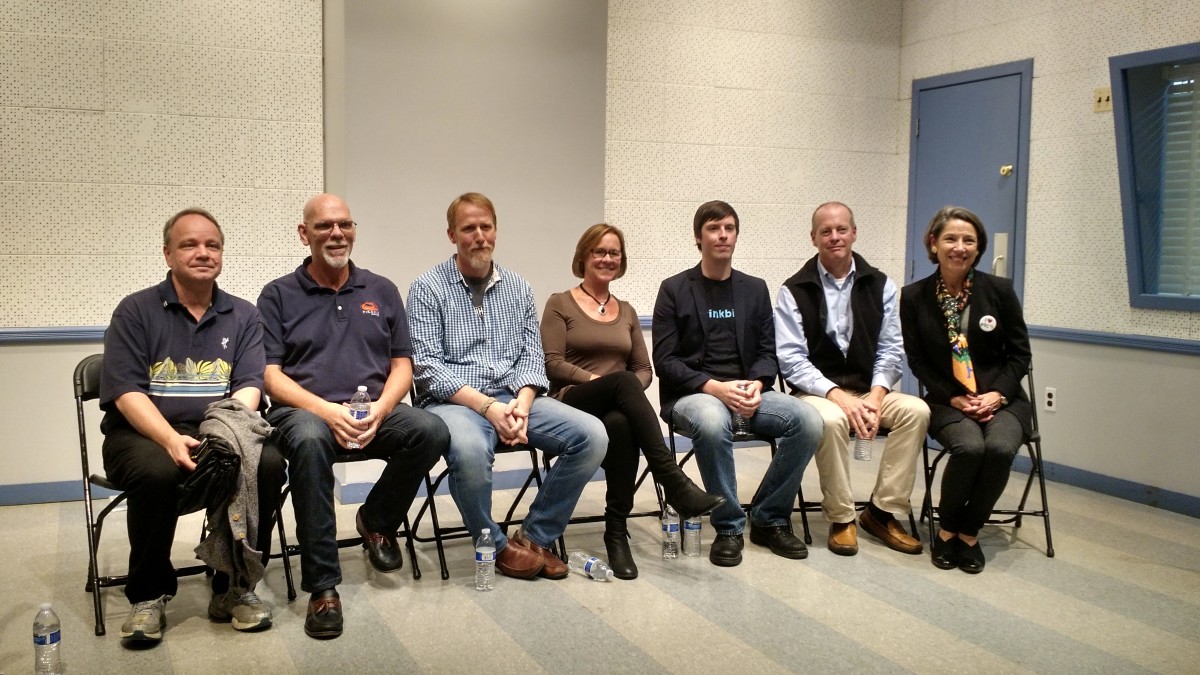Do you call Sid Meier the grandfather of the Baltimore video game industry? The godfather?
Deb Tillett, the executive director of the Emerging Technology Centers, thought each sounded too old in introducing the MicroProse and Firaxis founder at a Thursday panel about the history of video-game making held at the Baltimore Museum of Industry.
But whatever you call him, all but one of the seven people on the stage — including Tillett — got their starts in the business at MicroProse, which Meier and Bill Stealey (absent Thursday due to illness) started in 1982. The panel was part of Baltimore Innovation Week 2015.
“It’s the coolest, best, [most] fun job in the world,” said Meier, whose fingerprints have been on everything from Civilization to Pirates.
Joining him were Firaxis cofounder Jeff Briggs; Sparkypants Studios president Jason Coleman (late of MicroProse, Firaxis and Big Huge Games); Firaxis executive producer Kelley Gilmore; Brinkbit cofounder Bryan Bamford; and Digital Steamworks president Murray Taylor.
Several of them got their starts in the early days of computer gaming. Meier, before that.
“I was interested in gaming,” he said,” but we did not have computers.”
Instead, it was all about board games. It wasn’t until college that Meier actually got to use a computer, but it was far removed from today’s laptops and desktops. It was in a big room, not on a desk, and rather than thumb drives, you needed a shoebox of punch cards to get anything done.
“It was very large, it was behind glass,” he said. “I tried to merge my interest in games and computers.”
But when he tried to use those punch cards to make and play a game, a woman at the college told him something he never forgot: “Computers are not for games.”
It wasn’t until the Atari 800 in 1979 that Meier could really make something happen. But even then, it wasn’t easy. Gilmore shared a story of how, when pushing “Sid Meier’s Pirates” in 1987, Stealey would drive up and down I-95 with floppies and call Radio Shack stores in different voices asking if they carried the game as a way to wear managers down and get them to sell it.
Of the group, only Bamford had an educational background specifically related to gaming. Briggs studied music, Gilmore and Tillett were in more traditional marketing before taking up those tasks at Meier’s companies. And now, games are one of the most lucrative forms of media in the world.
“I love talking about it because it’s a legitimate business,” Gilmore said. “It’s bigger than the movie industry, and you can be a developer.”
Today, of course, the industry is far removed from the big computers of Meier’s college years. A game Bamford makes or a game made using Brinkbit’s platform can be sold on Steam or other digital marketplaces right next to the new Civilization, he said. Briggs took a research trip to Best Buy on Thursday and found no physical PC games at all. Mobile games like Candy Crush Saga are more and more popular.
https://twitter.com/Brinkbit/status/649746629608755200
“Certainly, change has been a constant in the industry,” Meier said. “A lot of the fundamentals of game development have not changed — taking [gamers] to a place in their imagination where they cannot go in real life.”
That reminded Bamford of something that happened once in a game design class at the Maryland Institute College of Art.
“They didn’t even want us to look at our computers, it was all about the board games,” he said.
Asked what kind of games that fascinate them now, Meier offered the unusual art direction of Minecraft, Coleman hat-tipped Monument Valley and Briggs had an unexpected choice: the Madden football series, for its constant iteration year over year.
“I just saw the last one and it’s like watching a television,” he said.
Asked how to get into the industry today, they all agreed the way in is by making games independently, with concepts all their own.
“Bring your passion to game design because otherwise, it’s about your favorite game that you’ve already played,” Meier said.
A game development exhibit at the Museum of Industry made with Meier’s participation will be open through 2019.







